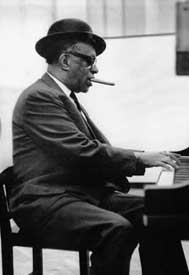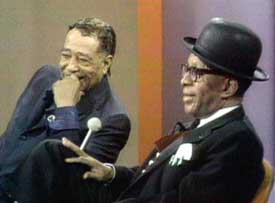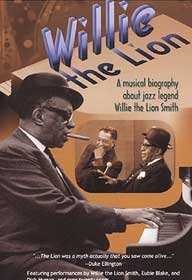As the documentary Willie the Lion (2001) begins, we hear the voice of Duke Ellington praising the film's subject, positing his influence on "the great Art Tatum." We are on our way along the outline of a man's creative life, one William Henry Joseph Bonaparte Bertholoff Smith, or WUllie the Lion Smith.
 From about 1905 he lived around "the Coast" redlight district of Newark where he played "gutbucket jazz" aka ragtime, out of which so much was to flow. in 1910 he was involved with James Reese Europe's agency called "the Clef Club" which got top jobs for black performers. From about 1905 he lived around "the Coast" redlight district of Newark where he played "gutbucket jazz" aka ragtime, out of which so much was to flow. in 1910 he was involved with James Reese Europe's agency called "the Clef Club" which got top jobs for black performers.
He began to work & live in the Atlantic City neighborhood called "the Line" far from the white folks' beach row. Here Willie perfected his Stride piano greatness, a method of playing that has more left-hand movement than ragtime.
To capture this era visually, the documentarian uses some primitive Edison films that in reality predate the era talked about, & this is just our first clue that this biography of a jazz pioneer will be fudged here & there because of a dirth of authentic film material featuring Willie. By the end we will also lack much of an idea of what his musical contribution sounded like or really was, though we'll have a fair understanding of historical position among great pianists.
After a stint in France World War I, wherein he proved himself as an heroic gunner & gained the sobriquet "the lion," he returned a decorated veteran, & lived in Harlem.
There he was a cantor in a Harlem synogogue, being a man who was as spiritual as he was musical. We see an elderly Artie Shaw reminiscing about Harlem days with Willie. As a white guy Shaw could easily have remained an outsider in the jazz scene. But, "Willie was my open sesame. He took me all over Harlem."
From 1920 through 1930 Willie played every night, all night, at LeRoy Wilkins' jazz club, the oldest in the city. The documentary tells too little about this era, but to fill in, Wilkins was a power to reckon with in Harlem whether it was politics or music.
For weekends, Wilkins insisted on a standard of dress among patrons & musicians alike that began with tuxedos, which is why the association of the tux with jazz would be lasting, though at first blush fancy dress seems hardly to relate to a musical form that began as a black cultural & veritably underground phenomenon among working people & youths.
Jazz began to reach white audiences with a Broadway musical review called "Shuffle Along" (1921), starring Eubie Blake & Noble Sissle who "started a vogue for black reviews that lasted the rest of the decade." But Willie the Lion continued to play clubs for black clientelle, & his name did not penetrate the larger society as greatly as did many of his great contemporaries.
But in Harlem, he was the lion. And anyone who expected to play jazz would be there, learning from just such masters. The stride pianists considered themselves the gladiators of jazz, & they had gladiatorial bouts of music so fast & so complex that only fellow musicians could fully understand its difficulty & its new perfections.
 A tour of Europe in the 1940s awakened afficionados worldwide to his importance, & his reputation in America reached a wider audience for a short while. A tour of Europe in the 1940s awakened afficionados worldwide to his importance, & his reputation in America reached a wider audience for a short while.
With his contemporaries Fats Waller & James P. Johnson there thrived "the big three" of Stride, & among them, Willie the Lion was the greatest virtuoso & influence on the next best jazz pianists of the era. The music was nurtured not only in black clubs but also in "parlor socials" which after hours parties with illegal booze, home cooking, & jazz.
His music is complex & difficult for even great pianists to reproduce, so his compositions were not often played by others, & the sheet music never sold well. And Willie was a hard, hard drinker which didn't help his career.
In 1964 he published his autobiography at Doubleday, & soon after there was a nostalgic awakening of interest in him & his music, & he even played the White House. In 1970 he was interviewed along with his great friend Duke Ellington on the David Frost Show. He died of cancer in 1973.
The documentary is a fair overview of a man & his art. Yet it fails to capture his music sufficiently, & coverage of his early life is fudged & deficient. Still, in the main, this is a decent film biography.
copyright © by Paghat the Ratgirl
|

 From about 1905 he lived around "the Coast" redlight district of Newark where he played "gutbucket jazz" aka ragtime, out of which so much was to flow. in 1910 he was involved with James Reese Europe's agency called "the Clef Club" which got top jobs for black performers.
From about 1905 he lived around "the Coast" redlight district of Newark where he played "gutbucket jazz" aka ragtime, out of which so much was to flow. in 1910 he was involved with James Reese Europe's agency called "the Clef Club" which got top jobs for black performers. A tour of Europe in the 1940s awakened afficionados worldwide to his importance, & his reputation in America reached a wider audience for a short while.
A tour of Europe in the 1940s awakened afficionados worldwide to his importance, & his reputation in America reached a wider audience for a short while.